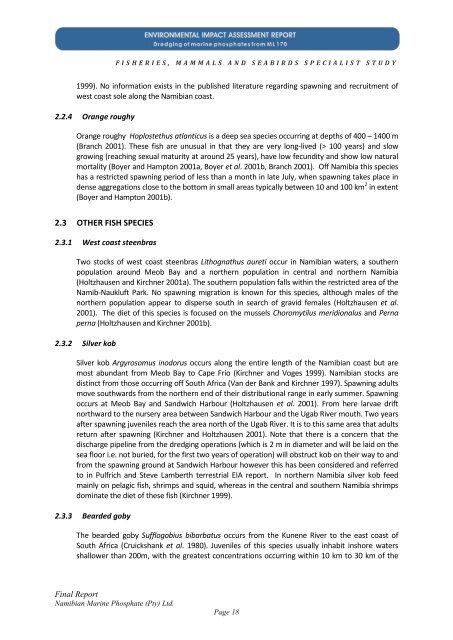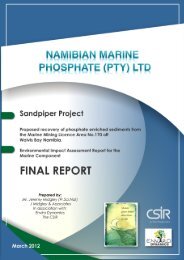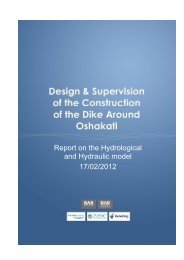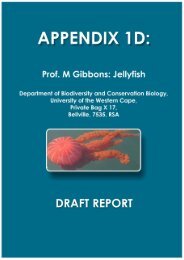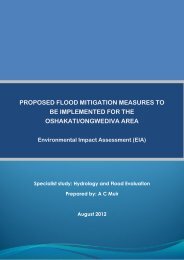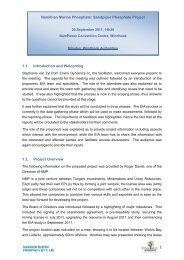Fisheries - Enviro Dynamics Namibia
Fisheries - Enviro Dynamics Namibia
Fisheries - Enviro Dynamics Namibia
You also want an ePaper? Increase the reach of your titles
YUMPU automatically turns print PDFs into web optimized ePapers that Google loves.
F I S H E R I E S , M A M M A L S A N D S E A B I R D S S P E C I A L I S T S T U D Y<br />
1999). No information exists in the published literature regarding spawning and recruitment of<br />
west coast sole along the <strong>Namibia</strong>n coast.<br />
2.2.4 Orange roughy<br />
Orange roughy Hoplostethus atlanticus is a deep sea species occurring at depths of 400 – 1400 m<br />
(Branch 2001). These fish are unusual in that they are very long-lived (> 100 years) and slow<br />
growing (reaching sexual maturity at around 25 years), have low fecundity and show low natural<br />
mortality (Boyer and Hampton 2001a, Boyer et al. 2001b, Branch 2001). Off <strong>Namibia</strong> this species<br />
has a restricted spawning period of less than a month in late July, when spawning takes place in<br />
dense aggregations close to the bottom in small areas typically between 10 and 100 km 2 in extent<br />
(Boyer and Hampton 2001b).<br />
2.3 OTHER FISH SPECIES<br />
2.3.1 West coast steenbras<br />
Two stocks of west coast steenbras Lithognathus aureti occur in <strong>Namibia</strong>n waters, a southern<br />
population around Meob Bay and a northern population in central and northern <strong>Namibia</strong><br />
(Holtzhausen and Kirchner 2001a). The southern population falls within the restricted area of the<br />
Namib-Naukluft Park. No spawning migration is known for this species, although males of the<br />
northern population appear to disperse south in search of gravid females (Holtzhausen et al.<br />
2001). The diet of this species is focused on the mussels Choromytilus meridionalus and Perna<br />
perna (Holtzhausen and Kirchner 2001b).<br />
2.3.2 Silver kob<br />
Silver kob Argyrosomus inodorus occurs along the entire length of the <strong>Namibia</strong>n coast but are<br />
most abundant from Meob Bay to Cape Frio (Kirchner and Voges 1999). <strong>Namibia</strong>n stocks are<br />
distinct from those occurring off South Africa (Van der Bank and Kirchner 1997). Spawning adults<br />
move southwards from the northern end of their distributional range in early summer. Spawning<br />
occurs at Meob Bay and Sandwich Harbour (Holtzhausen et al. 2001). From here larvae drift<br />
northward to the nursery area between Sandwich Harbour and the Ugab River mouth. Two years<br />
after spawning juveniles reach the area north of the Ugab River. It is to this same area that adults<br />
return after spawning (Kirchner and Holtzhausen 2001). Note that there is a concern that the<br />
discharge pipeline from the dredging operations (which is 2 m in diameter and will be laid on the<br />
sea floor i.e. not buried, for the first two years of operation) will obstruct kob on their way to and<br />
from the spawning ground at Sandwich Harbour however this has been considered and referred<br />
to in Pulfrich and Steve Lamberth terrestrial EIA report. In northern <strong>Namibia</strong> silver kob feed<br />
mainly on pelagic fish, shrimps and squid, whereas in the central and southern <strong>Namibia</strong> shrimps<br />
dominate the diet of these fish (Kirchner 1999).<br />
2.3.3 Bearded goby<br />
The bearded goby Sufflogobius bibarbatus occurs from the Kunene River to the east coast of<br />
South Africa (Cruickshank et al. 1980). Juveniles of this species usually inhabit inshore waters<br />
shallower than 200m, with the greatest concentrations occurring within 10 km to 30 km of the<br />
Final Report<br />
<strong>Namibia</strong>n Marine Phosphate (Pty) Ltd.<br />
Page 18


